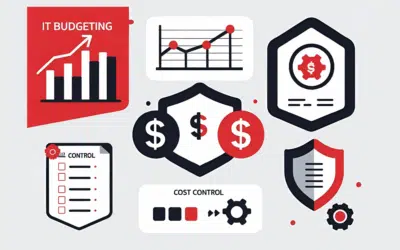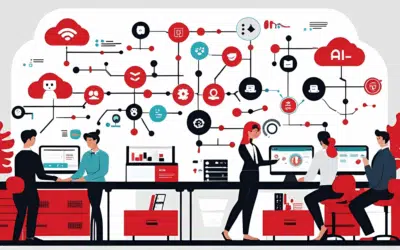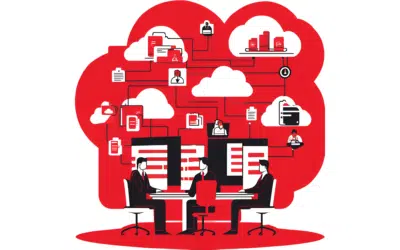In today’s fast-paced business landscape, small and medium-sized businesses (SMBs) are increasingly turning to technology as a cornerstone of their growth and sustainability strategies. As we step into 2024, it’s essential for these businesses to stay abreast of the evolving technological trends that can significantly impact their operations and competitiveness.
Understanding and leveraging the right technology has become more than just a means to streamline operations; it’s a strategic imperative for SMBs aiming to thrive in a dynamic market. The integration of cutting-edge technologies like automation, data analytics, and cybersecurity is no longer a luxury reserved for large corporations.
In this blog post, we delve into how these technologies are becoming increasingly accessible and beneficial for smaller businesses. We discuss real-world applications and practical steps SMBs can take to harness these trends effectively. Whether it’s automating routine tasks to free up resources, utilizing data to drive strategic decisions, or fortifying digital defenses against cyber threats, this post is a comprehensive guide to help SMBs navigate the technological landscape of 2024 and beyond.
Small Businesses and Automation
Today, more small businesses recognize the effectiveness of automation in enhancing efficiency and competitiveness. No longer limited to large corporations, technological advancements now make automation affordable and accessible for small and medium-sized enterprises. By automating routine tasks, these businesses free up time and resources for strategic initiatives, thereby increasing productivity and reducing operational costs.
Additionally, automation enhances accuracy by reducing the risk of human error. Consider a system that flawlessly manages your inventory, eliminating the need for tedious manual record keeping. Improved customer satisfaction often follows the adoption of automation, thanks to faster, more accurate service.
Real-world Applications of Automation
Let’s consider how small businesses utilize automation. Many automate their email marketing efforts to reach a larger audience without a corresponding increase in workload. They use software to schedule emails, segment audiences, and personalize messaging, ensuring timely and relevant communication with customers.
Further areas ripe for automation include billing, where software can auto-generate and send invoices, ensuring timely payments and reducing time spent on overdue bills. Many small businesses also use automation for project management and customer relationship management (CRM), using tools that track project progress and manage customer interactions efficiently.
At Axxys Technologies, we leverage automation to streamline helpdesk operations and network security scans (among other tasks), delivering more efficient and effective IT services to our customers around Texas and across the country.
Addressing Concerns about Automation
Despite these advantages, some small businesses are hesitant to adopt automation. Concerns typically stem from implementation costs and the challenge of integrating new technology into existing systems.
However, viewing automation as an investment rather than an expense can change this perspective. While there are initial costs, the long-term benefits in efficiency and accuracy typically offset these. As for integration concerns, numerous user-friendly software options exist that require minimal technical expertise. Most vendors also provide comprehensive support to ease the transition process. Furthermore, Axxys Technologies can lend a hand with getting your automation on track.
While it may seem intimidating, the benefits of automation make it a worthy consideration. By starting small and gradually implementing automated processes, small businesses can confidently prepare for the future.
Transforming into a Data-Driven Entity
Another emerging trend in technology is the increasing use of data. Data holds a pivotal role in decision-making for any size of company. With precise data, companies can make strategic decisions that spur growth and heighten competitiveness. Instead of relying on intuition, data offers solid proof to support decisions. By making the most out of data, companies can reveal trends, comprehend customer behavior, and predict future scenarios.
Practical Tools and Strategies for Data Interpretation
For a company to benefit from data, they require the proper tools and strategies, such as:
- Business intelligence software for collecting, analyzing, and visualizing data.
- Data analytics tools to discover trends and patterns.
- CRM systems are utilized to gain an understanding of the habits and inclinations of customers.
- Digital dashboards for showing real-time data that aids in swift decision making.
These tools aid companies in transforming raw data into actionable insights. However, possessing the appropriate equipment is merely a single aspect of the whole scenario. A triumphant data-driven method also needs a well-defined strategy, including setting objectives, pinpointing key metrics, and training staff to use these tools efficiently.
Examples of Data Interpretation
Companies worldwide are making the most of data. For example, some optimize their marketing initiatives by tailoring their messages to specific customer groups based on data insights. Others improve their supply chain by using real-time data to monitor inventory and guarantee punctual delivery.
Data can also optimize the customer experience as well as service delivery. By looking at data from the past, businesses can make informed decisions for the future that have a greater impact on business success.
With the appropriate approach and tools, data can transform small companies into industry leaders.
Adopting a Proactive Cybersecurity Stance
While networks, devices, and data have long been the targets of cybercriminals, 2024 will bring an even brighter spotlight to cybersecurity for small businesses.
Cybersecurity is not exclusive to large corporations. Cyber threats often target enterprises of small to medium size as well. These threats can lead to considerable financial loss and erode customer trust. Thus, a well-secured digital environment is as vital as a secure physical store or office, ensuring the safety of your business assets and smooth operations.
Proactive Cybersecurity: Prevention Over Cure
Many businesses often respond to cyber threats only after they happen. This reactive approach implies dealing with the aftermath of an attack. Conversely, a proactive stance involves preparing and defending your business before a potential attack. The approach comprises continual surveillance of the system, periodic evaluations of potential risks, and consistent updates to safety procedures. The main advantage of being proactive is that it aids in averting cyber threats, not just responding to them after they occur.
2024 will find more and more businesses taking a proactive approach to their security posture. At Axxys Technologies, we build all of our client IT solutions with strong security in mind. From proactive scanning to remaining abreast of new threat vectors, our team’s focus on security is a competitive advantage for our clients.
Boosting Cybersecurity in SMEs
How can you adopt a proactive cybersecurity stance? Begin by educating your team on cybersecurity importance and the risks associated with cyber threats. Encourage secure online behavior, such as using strong passwords and exercising caution with email attachments. Investing in trustworthy security software offering comprehensive protection can also be beneficial. Regular system updates and data backups add an extra defense layer. Cybersecurity is not a one-off task but an ongoing process requiring constant vigilance and proactive action.
More Emerging IT Trends for 2024
Expanding on the section titled “Unveiling IT Trends for 2024” reveals a dynamic and rapidly evolving landscape in which small and medium-sized businesses (SMBs) can find new opportunities for growth and efficiency. While automation, data-driven strategies, and cybersecurity remain foundational, several emerging trends are set to make significant impacts in the coming year. Here’s a deeper look at these trends.
Advanced Cloud Computing Solutions
Cloud technology has been a game-changer for businesses of all sizes, but in 2024, we’re looking at more advanced and specialized cloud services. This includes everything from multi-cloud strategies to hybrid cloud environments, offering SMBs greater flexibility, scalability, and cost-effectiveness. Cloud computing is no longer just about storage and basic applications; it’s about leveraging cloud infrastructure for advanced computing needs, like high-performance computing and AI-driven analytics.
Internet of Things (IoT) Integration
IoT technology is rapidly moving beyond consumer gadgets to become a core component of SMB operations. From smart inventory management systems to IoT-enabled supply chain monitoring, these connected devices offer real-time insights, improved efficiency, and reduced operational costs. SMBs can benefit from IoT data to optimize everything from energy usage to predictive maintenance.
Artificial Intelligence and Machine Learning
AI and ML are not just for big corporations or tech giants. In 2024, we will see more SMBs adopting AI for various purposes – from automating customer service with chatbots to leveraging machine learning algorithms for predictive analytics in sales and marketing. AI can help SMBs personalize customer experiences, optimize operations, and make more informed business decisions.
Blockchain
Blockchain technology is set to move beyond cryptocurrency applications. For SMBs, blockchain can offer enhanced security, transparency, and efficiency in various areas such as supply chain management, contract execution, and secure transactions. By incorporating blockchain, SMBs can reduce fraud, streamline operations, and build trust with customers and partners.
5G Implementation
The rollout of 5G networks will provide SMBs with faster and more reliable internet connectivity. This advancement will enable more robust IoT applications, enhance cloud computing capabilities, and open up new possibilities in remote work, virtual meetings, and augmented reality experiences.
Sustainable Technology Practices
With increasing awareness of environmental impact, 2024 will also see a trend towards sustainable technology practices. SMBs will be looking at ways to reduce their carbon footprint through energy-efficient technology, cloud computing (which can be more energy-efficient than traditional data centers), and digital processes that reduce the need for paper and physical materials.
Closing Thoughts
In conclusion, the IT landscape in 2024 is rich with opportunities for SMBs. By embracing these trends, businesses can not only enhance their operational efficiency and customer experience but also position themselves competitively in an increasingly digital world. It’s a time for SMBs to innovate, adapt, and thrive using the power of technology.
Technology is not merely an accessory but integral to the growth of your endeavors. As tech trends shift frequently, keeping in step helps you stay ahead in the competition. Don’t feel intimidated! Start with small actions, one trend at a time, and you’ll soon see tangible results.
Ready for these tech trends? Contact Axxys Technologies today and let’s get started making technology work for you!








